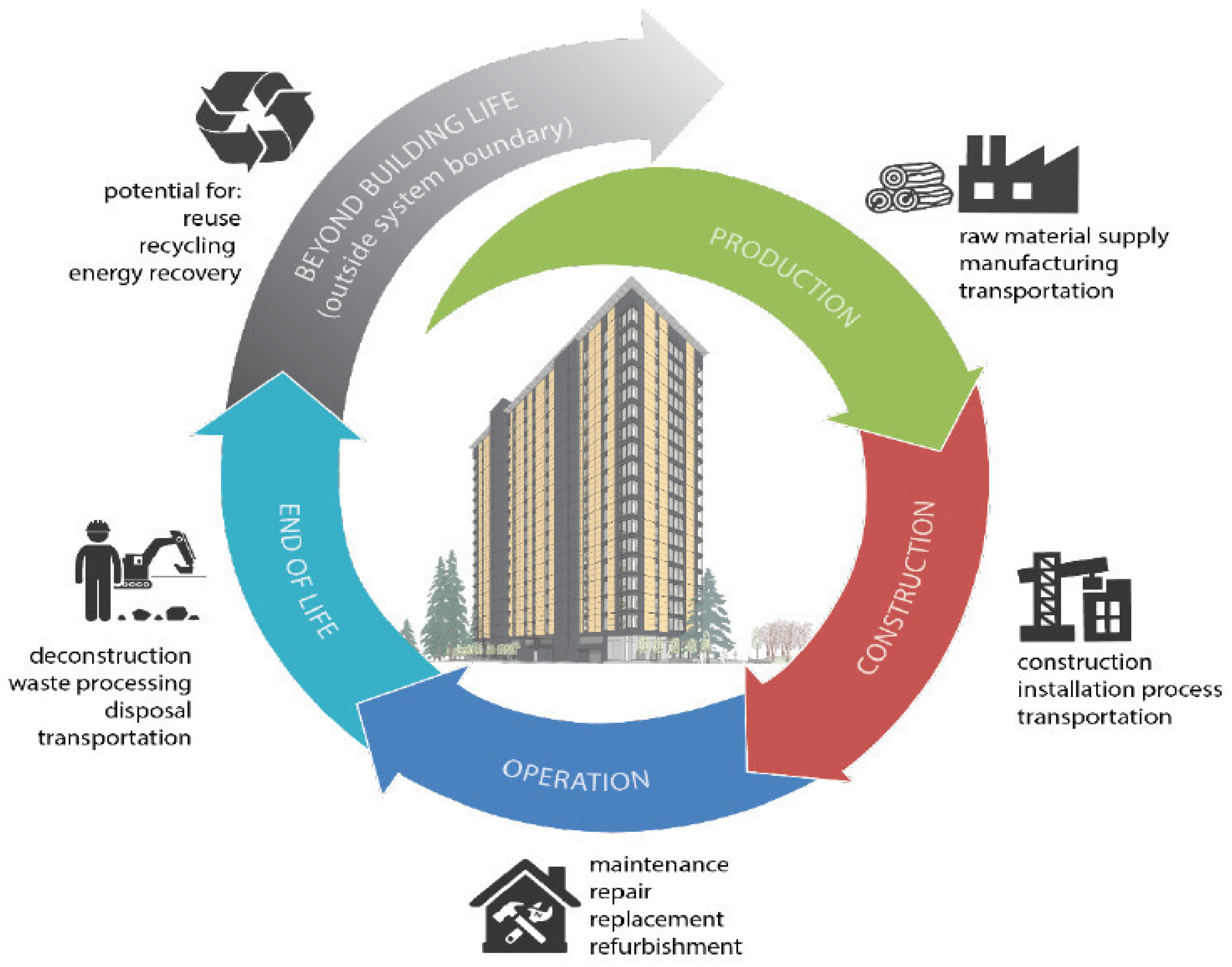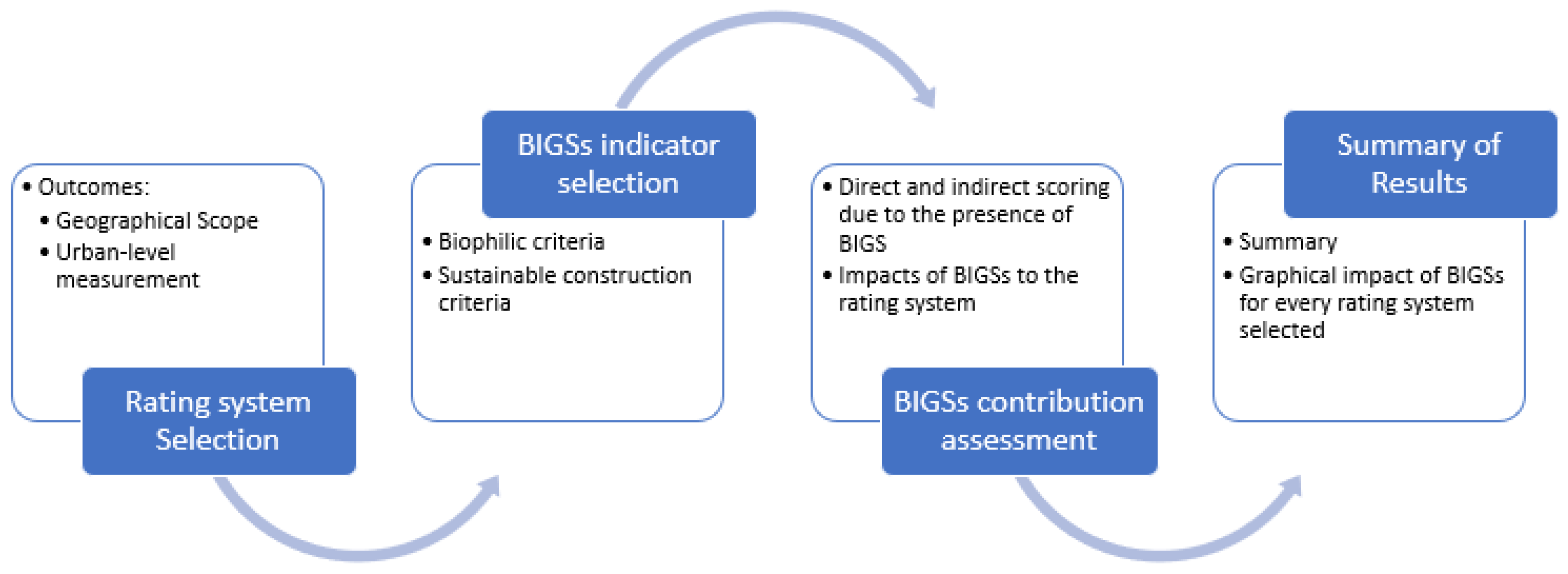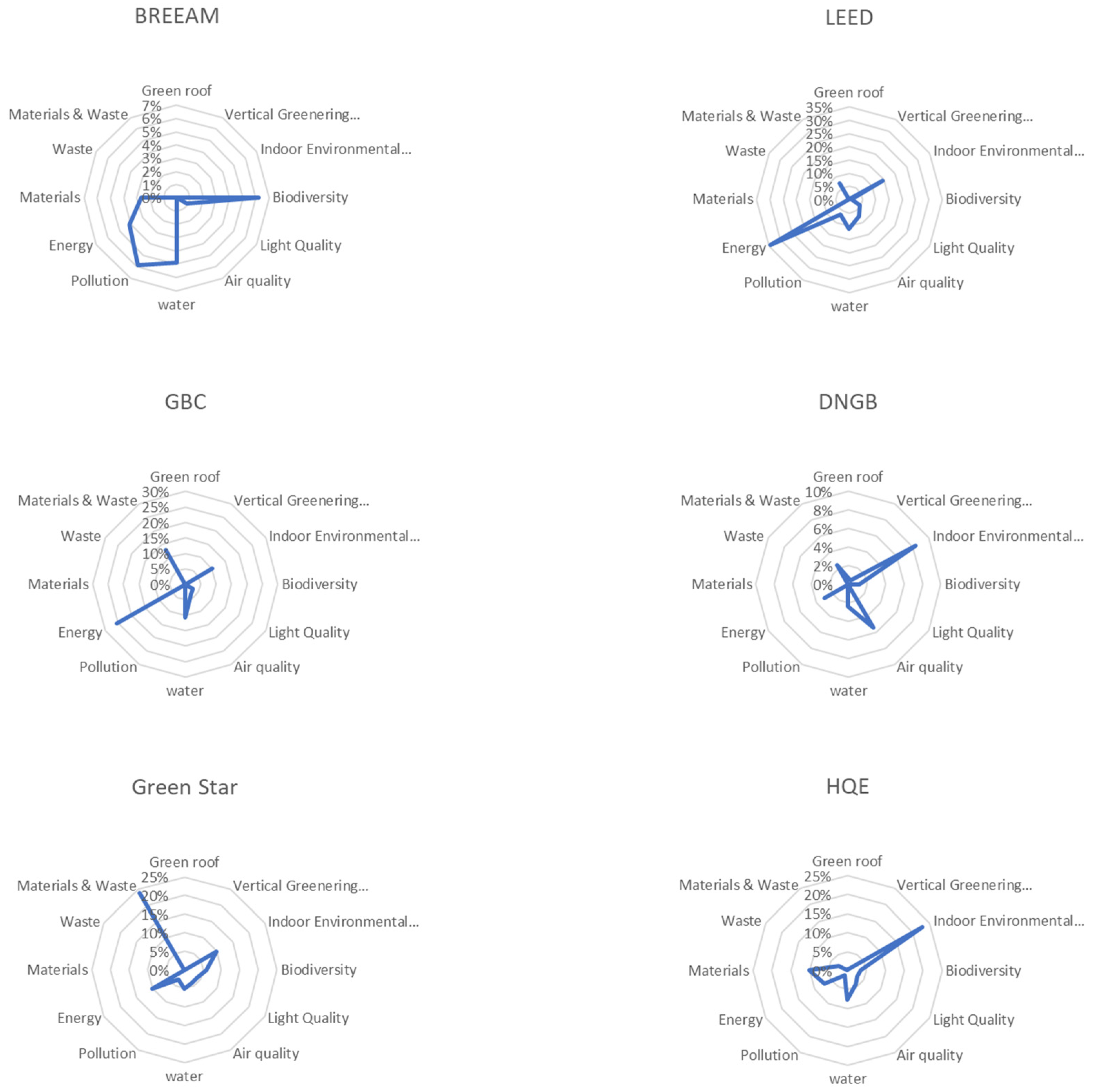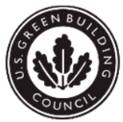The Role of Building-Integrated Greenery Systems in Building Sustainability Rating Systems
Abstract
:1. Introduction
2. Materials and Methods
3. Results
3.1. Certification Systems Selection (Step 1)
3.1.1. BREEAM [70]
3.1.2. LEED [73]
3.1.3. GBC [63]
- Sustainable Sites: Green roofs are valued under credits related to mitigating the urban heat island effect. Specific points are available for properties that implement solutions to minimize this effect, both on surfaces not covered by buildings and on the roofs themselves. Green roofs help to reduce the surface temperature and thus contribute to reductions in the urban heat island effect.
- Energy Efficiency: Research indicates that green roofs can improve the energy efficiency of buildings by providing additional insulation, which reduces the need for air conditioning and, consequently, energy consumption.
- Rainwater Management: Green roofs are also important for sustainable rainwater management, helping to absorb and retain rainwater, which can minimize runoff and improve water quality before it leaves the site.
3.1.4. DGNB [76]
3.1.5. Green Star [78]
3.1.6. HQE [81]
3.2. BIGS Contribution Indicator Identification and Assessment (Step 2 and Step 3)
3.2.1. BREEAM
3.2.2. LEED
3.2.3. GBC
3.2.4. DGNB
3.2.5. Green Star
- (a)
- Acoustic comfort—3 points;
- (b)
- Thermal comfort—2 points;
- (c)
- Sustainable sites—5 points;
- (d)
- Refrigerant impacts—1 point.
3.2.6. HQE
3.3. Summary of Results (Step 4)
4. Discussion
5. Conclusions
- Only the DGNB and HQE certification systems assign direct scoring in the evaluation process when a green infrastructure, such as a green roof or green facade, is implemented in a building. In contrast, BREEAM, LEED, GBC, and Green Star do not assign any direct credits or points to these green infrastructures. Instead, they allow scoring based on the benefits derived from the biophilic or sustainable construction criteria resulting from the implementation of such infrastructures.
- The six reviewed accreditation systems assign points to the benefits derived from the implementation of BIGSs, specifically in the categories of biophilic effects on building users and improvements in sustainability in sustainable construction.
- In the certification systems, the contributions of BIGSs to the following indicators were highlighted: improving indoor air quality, supporting biodiversity, optimizing water use, capturing pollutants, achieving energy savings, and utilizing sustainable materials.
- There is still a lack of alignment between contrasting scientific evidence on the multiple benefits of BIGSs in the built environment and the value assigned to them in the analyzed certification systems; for example, the ability of BIGSs in providing acoustic insulation and reducing urban noise.
- The analyzed rating systems do not align with the needs of arid environments and the contributions that BIGSs can make for these climates. Future studies should review which certifications apply to specific climates and identify the most effective technologies.
- BIGSs provide thermal insulation, reducing the need for artificial cooling and thereby lowering energy consumption. This is particularly emphasized in the LEED, GBC, and Green Star certification systems, where energy management is a critical component.
- BIGSs help in capturing and reusing rainwater, which is vital in regions with limited water resources. LEED certification recognizes this contribution significantly, as does the GBC system, which values rainwater management highly.
- Improved indoor environmental conditions due to the presence of BIGSs are particularly valued in arid climates. The HQE certification system places significant emphasis on this benefit, recognizing the role of BIGSs in enhancing indoor air quality and thermal comfort, which reduces the energy demand for cooling.
- BIGSs help improve urban microclimates, which is a significant issue in arid climates. This aspect is acknowledged indirectly in the BREEAM rating system along with other indirect contributions to the certification process such as rainwater management and the development of an ecological strategy.
Author Contributions
Funding
Data Availability Statement
Acknowledgments
Conflicts of Interest
References
- Dsilva, J.; Zarmukhambetova, S.; Locke, J. Assessment of building materials in the construction sector: A case study using life cycle assessment approach to achieve the circular economy. Heliyon 2023, 9, e20404. [Google Scholar] [CrossRef]
- Le Boulzec, H.; Mathy, S.; Verzier, F.; Andrieu, B.; Monfort-Climent, D.; Vidal, O. Material requirements and impacts of the building sector in the Shared Socioeconomic Pathways. J. Clean. Prod. 2023, 428, 139117. [Google Scholar] [CrossRef]
- Abushanab, A.; Alnahhal, W. Life cycle cost analysis of sustainable reinforced concrete buildings with treated wastewater, recycled concrete aggregates, and fly ash. Results Eng. 2023, 20, 101565. [Google Scholar] [CrossRef]
- Gholami Rostam, M.; Abbasi, A. Integrating construction and demolition waste impact categories into building energy optimization through a conceptual sustainability-oriented model. J. Clean. Prod. 2022, 378, 134543. [Google Scholar] [CrossRef]
- Sai Trivedi, S.; Snehal, K.; Das, B.B.; Barbhuiya, S. A comprehensive review towards sustainable approaches on the processing and treatment of construction and demolition waste. Constr. Build. Mater. 2023, 393, 132125. [Google Scholar] [CrossRef]
- ArchDaily. Understanding Whole Building Life Cycle Assessment for a Better Architecture. Available online: https://www.archdaily.com/995421/understanding-whole-building-life-cycle-assessment-for-a-better-architecture (accessed on 6 May 2024).
- Illankoon, I.M.C.S.; Tam, V.W.Y.; Le, K.N.; Shen, L. Key credit criteria among international green building rating tools. J. Clean. Prod. 2017, 164, 209–220. [Google Scholar] [CrossRef]
- Mattoni, B.; Guattari, C.; Evangelisti, L.; Bisegna, F.; Gori, P.; Asdrubali, F. Critical review and methodological approach to evaluate the differences among international green building rating tools. Renew. Sustain. Energy Rev. 2018, 82, 950–960. [Google Scholar] [CrossRef]
- USGBC. Green Building for Everyone within a Generation. Available online: https://www.usgbc.org/about/mission-vision (accessed on 6 May 2024).
- Manso, M.; Teotónio, I.; Silva, C.M.; Cruz, C.O. Green roof and green wall benefits and costs: A review of the quantitative evidence. Renew. Sustain. Energy Rev. 2020, 135, 110111. [Google Scholar] [CrossRef]
- Lee, E.; Seo, Y.; Woo, D.K. Enhanced environmental and economic benefits of green roofs in a humid subtropical region under future climate. Ecol. Eng. 2024, 201, 107221. [Google Scholar] [CrossRef]
- Ma’bdeh, S.N.; Ali, H.H.; Rabab’ah, I.O. Sustainable assessment of using green roofs in hot-arid areas—Residential buildings in Jordan. J. Build. Eng. 2022, 45, 103559. [Google Scholar] [CrossRef]
- Aboelata, A. Assessment of green roof benefits on buildings’ energy-saving by cooling outdoor spaces in different urban densities in arid cities. Energy 2021, 219, 119514. [Google Scholar] [CrossRef]
- Ávila-Hernández, A.; Simá, E.; Xamán, J.; Hernández-Pérez, I.; Téllez-Velázquez, E.; Chagolla-Aranda, M.A. Test box experiment and simulations of a green-roof: Thermal and energy performance of a residential building standard for Mexico. Energy Build. 2020, 209, 109709. [Google Scholar] [CrossRef]
- Saadatian, O.; Sopian, K.; Salleh, E.; Lim, C.H.; Riffat, S.; Saadatian, E.; Toudeshki, A.; Sulaiman, M.Y. A review of energy aspects of green roofs. Renew. Sustain. Energy Rev. 2013, 23, 155–168. [Google Scholar] [CrossRef]
- Azkorra, Z.; Pérez, G.; Coma, J.; Cabeza, L.F.; Bures, S.; Álvaro, J.E.; Erkoreka, A.; Urrestarazu, M. Evaluation of green walls as a passive acoustic insulation system for buildings. Appl. Acoust. 2015, 89, 46–56. [Google Scholar] [CrossRef]
- Connelly, M.; Hodgson, M. Experimental investigation of the sound transmission of vegetated roofs. Appl. Acoust. 2013, 74, 1136–1143. [Google Scholar] [CrossRef]
- Pérez, G.; Coma, J.; Barreneche, C.; De Gracia, A.; Urrestarazu, M.; Burés, S.; Cabeza, L.F. Acoustic insulation capacity of Vertical Greenery Systems for buildings. Appl. Acoust. 2016, 110, 218–226. [Google Scholar] [CrossRef]
- Van Renterghem, T.; Hornikx, M.; Forssen, J.; Botteldooren, D. The potential of building envelope greening to achieve quietness. Build. Environ. 2013, 61, 34–44. [Google Scholar] [CrossRef]
- Van Renterghem, T.; Botteldooren, D. Reducing the acoustical façade load from road traffic with green roofs. Build. Environ. 2009, 44, 1081–1087. [Google Scholar] [CrossRef]
- Perez, G.; Perini, K. Nature Based Strategies for Urban and Building Sustainabilty; Elsevier: Amsterdam, The Netherlands, 2018. [Google Scholar]
- Leal Filho, W.; Echevarria Icaza, L.; Emanche, V.; Quasem Al-Amin, A. An Evidence-Based Review of Impacts, Strategies and Tools to Mitigate Urban Heat Islands. Int. J. Environ. Res. Public Health 2017, 14, 1600. [Google Scholar] [CrossRef]
- Susca, T.; Gaffin, S.R.; Dell’Osso, G.R. Positive effects of vegetation: Urban heat island and green roofs. Environ. Pollut. 2011, 159, 2119–2126. [Google Scholar] [CrossRef]
- Burszta-Adamiak, E. Analysis of the retention capacity of green roofs. J. Water Land Dev. 2012, 16, 3–9. [Google Scholar] [CrossRef]
- Carter, T.L.; Rasmussen, T.C. Hydrologic Behavior of Vegetated Roofs. JAWRA J. Am. Water Resour. Assoc. 2006, 42, 1261–1274. [Google Scholar] [CrossRef]
- Musa, S.; Arish, N.A.M.; Jalil, M.R.; Kasmin, H.; Mansor, M.S. Potential of Storm Water Capacity Using Vegetated Roofs in Malaysia. In Proceedings of the International Conference on Civil Engineering Practice (ICCE08), Kuantan, Pahang, Malaysia, 12–14 May 2008. [Google Scholar]
- Shafique, M.; Kim, R.; Kyung-Ho, K. Green Roof for Stormwater Management in a Highly Urbanized Area: The Case of Seoul, Korea. Sustainability 2018, 10, 584. [Google Scholar] [CrossRef]
- Uhl, M.; Schiedt, L. Green Roof Storm Water Retention—Monitoring Results. In Proceedings of the 11th International Conference on Urban Drainage, Edinburgh, Scotland, UK, 31 August–5 September 2008. [Google Scholar]
- Brenneisen, S. Space for Urban Wildlife: Designing Green Roofs as Habitats in Switzerland. Urban Habitats 2006, 4, 27–36. [Google Scholar]
- Collins, R.; Schaafsma, M.; Hudson, M.D. The value of green walls to urban biodiversity. Land Use Policy 2017, 64, 114–123. [Google Scholar] [CrossRef]
- Dunnett, N. Green roofs for biodiversity: Reconciling aesthetics with ecology. In Proceedings of the 4th Annual Greening Rooftops for Sustainable Communities, Boston, MA, USA, 11–12 May 2006. [Google Scholar]
- Mayrand, F.; Clergeau, P. Green Roofs and Green Walls for Biodiversity Conservation: A Contribution to Urban Connectivity? Sustainability 2018, 10, 985. [Google Scholar] [CrossRef]
- Williams, N.S.G.; Lundholm, J.; Scott MacIvor, J. FORUM: Do green roofs help urban biodiversity conservation? J. Appl. Ecol. 2014, 51, 1643–1649. [Google Scholar] [CrossRef]
- Czemiel Berndtsson, J. Green roof performance towards management of runoff water quantity and quality: A review. Ecol. Eng. 2010, 36, 351–360. [Google Scholar] [CrossRef]
- Jayasooriya, V.M.; Ng, A.W.M.; Muthukumaran, S.; Perera, B.J.C. Green infrastructure practices for improvement of urban air quality. Urban For. Urban Green. 2017, 21, 34–47. [Google Scholar] [CrossRef]
- Pradhan, S.; Al-Ghamdi, S.G.; Mackey, H.R. Greywater recycling in buildings using living walls and green roofs: A review of the applicability and challenges. Sci. Total Environ. 2019, 652, 330–344. [Google Scholar] [CrossRef]
- Prodanovic, V.; Hatt, B.; McCarthy, D.; Zhang, K.; Deletic, A. Green walls for greywater reuse: Understanding the role of media on pollutant removal. Ecol. Eng. 2017, 102, 625–635. [Google Scholar] [CrossRef]
- Pugh, T.A.M.; MacKenzie, A.R.; Whyatt, J.D.; Hewitt, C.N. Effectiveness of Green Infrastructure for Improvement of Air Quality in Urban Street Canyons. Environ. Sci. Technol. 2012, 46, 7692–7699. [Google Scholar] [CrossRef] [PubMed]
- Rowe, D.B. Green roofs as a means of pollution abatement. Environ. Pollut. 2011, 159, 2100–2110. [Google Scholar] [CrossRef]
- Yang, J.; Yu, Q.; Gong, P. Quantifying air pollution removal by green roofs in Chicago. Atmos. Environ. 2008, 42, 7266–7273. [Google Scholar] [CrossRef]
- Hedblom, M.; Gunnarsson, B.; Iravani, B.; Knez, I.; Schaefer, M.; Thorsson, P.; Lundström, J.N. Reduction of physiological stress by urban green space in a multisensory virtual experiment. Sci. Rep. 2019, 9, 10113. [Google Scholar] [CrossRef] [PubMed]
- Kabisch, N.; Van Den Bosch, M.; Lafortezza, R. The health benefits of nature-based solutions to urbanization challenges for children and the elderly—A systematic review. Environ. Res. 2017, 159, 362–373. [Google Scholar] [CrossRef] [PubMed]
- Van Den Berg, A.E.; Wesselius, J.E.; Maas, J.; Tanja-Dijkstra, K. Green Walls for a Restorative Classroom Environment: A Controlled Evaluation Study. Environ. Behav. 2017, 49, 791–813. [Google Scholar] [CrossRef]
- Guidelines for the Planning, Construction and Maintenance of Green Roofs. Landscape Development and Landscaping Re-Search Society e.V. (FLL). 2018. Available online: https://shop.fll.de/de/green-roof-guidelines-2018-download.html (accessed on 6 May 2024).
- WGIN. Home—World Green Infrastructure Network. Welcome to the World Green Infrastructure Network. Available online: https://worldgreeninfrastructurenetwork.org/ (accessed on 6 May 2024).
- Greenroofs.com LLC. Greenroofs.com—Connecting the Planet + Living Architecture. Available online: https://www.greenroofs.com/ (accessed on 7 May 2024).
- Mousavi, S.; Gheibi, M.; Wacławek, S.; Smith, N.R.; Hajiaghaei-Keshteli, M.; Behzadian, K. Low-energy residential building optimisation for energy and comfort enhancement in semi-arid climate conditions. Energy Convers. Manag. 2023, 291, 117264. [Google Scholar] [CrossRef]
- Robbiati, F.O.; Natalia, C.; Gustavo, B.; Gustavo, O.; Jim, C.Y.; Mario, S.; Emmanuel, H.; Rubio, E.; Leonardo, G.; Lelia, I. Vegetated roofs as a nature-based solution to mitigate climate change in a semiarid city. Nat.-Based Solut. 2023, 3, 100069. [Google Scholar] [CrossRef]
- González-Méndez, B.; Chávez-García, E. Re-thinking the Technosol design for greenery systems: Challenges for the provision of ecosystem services in semiarid and arid cities. J. Arid Environ. 2020, 179, 104191. [Google Scholar] [CrossRef]
- Abdeen, N.; Rafaat, T. Assessing vertical green walls for indoor corridors in educational buildings and its impact outdoor: A field study at the universities of Canada in Egypt. Results Eng. 2024, 21, 101838. [Google Scholar] [CrossRef]
- Reyes, R.; Bustamante, W.; Gironás, J.; Pastén, P.A.; Rojas, V.; Suárez, F.; Vera, S.; Victorero, F.; Bonilla, C.A. Effect of substrate depth and roof layers on green roof temperature and water requirements in a semi-arid climate. Ecol. Eng. 2016, 97, 624–632. [Google Scholar] [CrossRef]
- Carlucci, S.; Charalambous, M.; Tzortzi, J.N. Monitoring and performance evaluation of a green wall in a semi-arid Mediterranean climate. J. Build. Eng. 2023, 77, 107421. [Google Scholar] [CrossRef]
- Sheng, L.X.; Rosemary, A.; Mohd, B.; Hussein, H.B. Assessing the Green Roof Technology in Green Building Rating Systems. In Proceedings of the International Building & Infrastructure Technology Conference, Penang, Malaysia, 7–8 June 2011; pp. 50–56. [Google Scholar]
- Mazur, Ł.; Resler, M.; Koda, E.; Walasek, D.; Daria Vaverková, M. Energy saving and Green building Certification: Case study of commercial buildings in Warsaw, Poland. Sustain. Energy Technol. Assess. 2023, 60, 103520. [Google Scholar] [CrossRef]
- Wu, P.; Mao, C.; Wang, J.; Song, Y.; Wang, X. A decade review of the credits obtained by LEED v2.2 certified green building projects. Build. Environ. 2016, 102, 167–178. [Google Scholar] [CrossRef]
- Gurgun, A.P.; Komurlu, R.; Arditi, D. Review of the LEED Category in Materials and Resources for Developing Countries. Procedia Eng. 2015, 118, 1145–1152. [Google Scholar] [CrossRef]
- Mahdavinejad, M.; Zia, A.; Larki, A.N.; Ghanavati, S.; Elmi, N. Dilemma of green and pseudo green architecture based on LEED norms in case of developing countries. Int. J. Sustain. Built Environ. 2014, 3, 235–246. [Google Scholar] [CrossRef]
- BREEAM Projects. Available online: https://tools.breeam.com/projects/explore/map.jsp (accessed on 1 July 2024).
- Cole, R.J.; Jose Valdebenito, M. The importation of building environmental certification systems: International usages of BREEAM and LEED. Build. Res. Inf. 2013, 41, 662–676. [Google Scholar] [CrossRef]
- Bernardi, E.; Carlucci, S.; Cornaro, C.; Bohne, R.A. An Analysis of the Most Adopted Rating Systems for Assessing the Environmental Impact of Buildings. Sustainability 2017, 9, 1226. [Google Scholar] [CrossRef]
- Assadiki, R.; Belmir, F. Current Situation of Green Building Development in Morocco: Standards and Certification Systems. In Proceedings of the Digital Technologies and Applications; Motahhir, S., Bossoufi, B., Eds.; Springer International Publishing: Cham, Switzerland, 2022; pp. 563–572. [Google Scholar]
- Tecnalia Jornada Los Beneficios de BIM-HQE-BREEAM-LEED-WELL. Available online: http://www.bioeconomic.es/Ponencias/BIMBREEAMSebastian/junio%20Presentacion%20HQE-TECNALIA_comp.pdf (accessed on 1 July 2024).
- WGBC, World Green Building Council. Available online: https://worldgbc.org/ (accessed on 7 May 2024).
- Jordan Green Building Council. Jordan GBC Core Value. Available online: https://jordangbc.org/-GBC-Core-Value (accessed on 1 July 2024).
- E-Motion Creative Egypt GBC. Statements. Available online: https://www.egyptgbc.org/en/statements (accessed on 1 July 2024).
- GBCE. Green Building Council España—Consejo Para la Edificación Sostenible en España es la Principal Organización de Edificación Sostenible en Nuestro País, La Edificación Sostenible. Available online: https://gbce.es/ (accessed on 7 May 2024).
- Mishra, A.; Kauškale, L. The Analysis of the Green Building Supporting Organisations in the Scandinavian Countries and Baltic States. Balt. J. Real Estate Econ. Constr. Manag. 2018, 6, 201–219. [Google Scholar] [CrossRef]
- Tebbouche, H.; Bouchair, A.; Grimes, S. Towards an environmental approach for the sustainability of buildings in Algeria. Energy Procedia 2017, 119, 98–110. [Google Scholar] [CrossRef]
- Wen, B.; Musa, N.; Onn, C.C.; Ramesh, S.; Liang, L.; Wang, W. Evolution of sustainability in global green building rating tools. J. Clean. Prod. 2020, 259, 120912. [Google Scholar] [CrossRef]
- BRE, BREEAM—BRE Group—Liferay DXP, BRE Group. Available online: https://bregroup.com/products/breeam (accessed on 7 May 2024).
- Naranjo, A.; Colonia, A.; Mesa, J.; Maury, H.; Maury-Ramírez, A. State-of-the-Art Green Roofs: Technical Performance and Certifications for Sustainable Construction. Coatings 2020, 10, 69. [Google Scholar] [CrossRef]
- Hussien, A.; Jannat, N.; Mushtaha, E.; Al-Shammaa, A. A holistic plan of flat roof to green-roof conversion: Towards a sustainable built environment. Ecol. Eng. 2023, 190, 106925. [Google Scholar] [CrossRef]
- USGBC. LEED Rating System|U.S. Green Building Council, LEED Rating System. Available online: https://www.usgbc.org/leed (accessed on 7 May 2024).
- Feng, H.; Hewage, K. Energy saving performance of green vegetation on LEED certified buildings. Energy Build. 2014, 75, 281–289. [Google Scholar] [CrossRef]
- Green Building Council of Sri Lanka. GREENSL® RATING SYSTEM FOR NEW CONSTRUCTIONS. Green Building Council of Sri Lanka, 2022. Available online: https://www.srilankagbc.org/wp-content/uploads/2022/08/Green-Building-Rating-System-Version-2.1-FINAL-25-02-2022-1.pdf (accessed on 7 May 2024).
- DGNB GmbH German Sustainable Building Council|DGNB, Sustainable Building with the DGNB. Available online: https://www.dgnb.de/en (accessed on 7 May 2024).
- Poorova, Z.; Vranay, F.; AlHosni, M.S.; Vranayova, Z. Importance of Different Vegetation Used on Green Roofs in Terms of Lowering Temperature and Water Retention. Procedia Eng. 2016, 162, 39–44. [Google Scholar] [CrossRef]
- GBCA, Home|Green Building Council of Australia, Green Building Council Australia. Available online: https://new.gbca.org.au/ (accessed on 7 May 2024).
- Ding, Z.; Fan, Z.; Tam, V.W.Y.; Bian, Y.; Li, S.; Illankoon, I.M.C.S. Green building evaluation system implementation. Build. Environ. 2018, 133, 32–40. [Google Scholar] [CrossRef]
- Alwisy, A.; BuHamdan, S.; Gül, M. Criteria-based ranking of green building design factors according to leading rating systems. Energy Build. 2018, 178, 347–359. [Google Scholar] [CrossRef]
- Mazur, Ł.; Bać, A.; Vaverková, M.D.; Winkler, J.; Nowysz, A.; Koda, E. Evaluation of the Quality of the Housing Environment Using Multi-Criteria Analysis That Includes Energy Efficiency: A Review. Energies 2022, 15, 7750. [Google Scholar] [CrossRef]
- HQE, Accueil de l’Alliance-HQE-GBC, Alliance HQE-GBC. Available online: https://www.hqegbc.org/ (accessed on 7 May 2024).
- Korol, E.; Shushunova, N. Green Roofs: Standardization and Quality Control of Processes in Green Construction. MATEC Web Conf. 2017, 106, 06014. [Google Scholar] [CrossRef]
- BRE. KLM Leads the Way in Retail with Their Future-Proof and Sustainable Shopping Mall. BRE Case Studies. 2015. Available online: https://bregroup.com/case-studies/breeam-in-use/klm-leads-the-way-in-retail-with-their-future-proof-and-sustainable-shopping-mall/ (accessed on 7 May 2024).
- Sabory, N.R.; Senjyu, T.; Momand, A.H.; Waqfi, H.; Saboor, N.; Mobarez, R.; Razeqi, F. Leed scores of residential buildings in poor cities: Kabul city case. Sustain. Switz. 2021, 13, 6959. [Google Scholar] [CrossRef]
- Michaud, A.; Perebynos, A.R. French Green Building Rating Systems. Encycl. Sustain. Technol. 2018, 3, 99–112. [Google Scholar]
- Zuckerman, N.; Lensky, I.M. Thermal performance of vertical greenery systems (VGS) in a street canyon: A real-scale long-term experiment. Build. Environ. 2023, 244, 110750. [Google Scholar] [CrossRef]
- United Nations. Transforming Our World: The 2030 Agenda for Sustainable Development; n.o October. en Resolution Adopted by the General Assembly on 25 September 2015; Palgrave Macmillan: London, UK, 2015. [Google Scholar] [CrossRef]
- Sánchez Cordero, A.; Gómez Melgar, S.; Andújar Márquez, J.M. Green building rating systems and the new framework level(s): A critical review of sustainability certification within Europe. Energies 2020, 13, 66. [Google Scholar] [CrossRef]
- Zhang, Y.; Zhang, L.; Ma, L.; Meng, Q.; Ren, P. Cooling benefits of an extensive green roof and sensitivity analysis of its parameters in subtropical areas. Energies 2019, 12, 4278. [Google Scholar] [CrossRef]
- Perini, K.; Rosasco, P. Cost e bene fi t analysis for green façades and living wall systems. Build. Environ. 2013, 70, 110–121. [Google Scholar] [CrossRef]
- Pérez, G.; Coma, J.; Sol, S.; Cabeza, L.F. Green facade for energy savings in buildings: The influence of leaf area index and facade orientation on the shadow effect. Appl. Energy 2017, 187, 424–437. [Google Scholar] [CrossRef]
- Evangelisti, L.; Guattari, C.; Grazieschi, G.; Roncone, M.; Asdrubali, F. On the energy performance of an innovative green roof in the mediterranean climate. Energies 2020, 13, 5163. [Google Scholar] [CrossRef]
- Abhijith, K.V.; Kukadia, V.; Kumar, P. Investigation of air pollution mitigation measures, ventilation, and indoor air quality at three schools in London. Atmos. Environ. 2022, 289, 119303. [Google Scholar] [CrossRef]
- Assefa, S.; Lee, H.-Y.; Shiue, F.-J. Sustainability Performance of Green Building Rating Systems (GBRSs) in an Integration Model. Buildings 2022, 12, 208. [Google Scholar] [CrossRef]
- Qualitel HQE Residential Certificacion Scheme. Available online: https://www.qualitel.org/professionnels/uploads/Technical-requirements-guide-For-built-and-renovated-residential-buildings-performance-ENG-022023.pdf (accessed on 15 July 2024).
- Ferrari, S.; Zoghi, M.; Blázquez, T.; Dall’O, G. New Level(s) framework: Assessing the affinity between the main international Green Building Rating Systems and the european scheme. Renew. Sustain. Energy Rev. 2022, 155, 111924. [Google Scholar] [CrossRef]
- Marchi, L.; Antonini, E.; Politi, S. Green Building Rating Systems (GBRSs). Encyclopedia 2021, 1, 998–1009. [Google Scholar] [CrossRef]



| Country | Building Rating System |
|---|---|
| Australia | Nabers/Green Star/BASIX |
| Brazil | AQUA/LEED Brasil |
| Arab Emirates | Estidama |
| Canada | LEED Canada/Green Globes/Built Green Canada |
| China | GBAS |
| Philippines | BERDE/Philippine Green Building Council |
| Finland | PromisE |
| France | HQE |
| Spain | VERDE |
| Netherlands | BREEAM Netherlands |
| Hong Kong | HKBEAM |
| India | Indian Green Building Council (IGBC)/GBCIndia/GRIHA |
| Indonesia | Green Building Council Indonesia (GBCI)/Greenship |
| Japan | CASBEE |
| Jordan | Jordan Green Building Council |
| Qatar | QSAS |
| Korea | Green Building Certification Criteria/ Korea Green Building Council |
| Malaysia | BBI Malaysia |
| Mexico | LEED Mexico The Green Business Certification Inc. (GBCI) |
| Germany | DGNB/CEPHEUS |
| New Zealand | Green Star NZ |
| Pakistan | SEED—Specific Green Building Guideline |
| (Pakistan Green Building Council) | |
| Poland | Green house (Polish Green Building Council (PLGBC)) |
| Portugal | Lider A/SBToolPT® |
| Czech Republic | SBToolCZ |
| Republic of South Africa | Green Star SA |
| Romania | Green homes (ROGBC) |
| Singapore | Green Mark |
| Switzerland | Minergie |
| Thailand | TREES |
| Taiwan | Green Building Label |
| Turkey | CEDBIK |
| US | LEED/Living Building Challenge/Green Globes/Build it Green/NAHB NGBS/International Green Construction Code (IGCC)/ENERGY STAR |
| United Kingdom | BREEAM |
| Vietnam | LOTUS Rating Tools |
| Italy | Protocollo Itaca/Green Building Council Italia |
| European Commission | LEVELS |
| Brand Name | Country of Origin | Logo | Website |
|---|---|---|---|
| BREEAM | UK |  | https://bregroup.com/products/breeam/ (accessed on 22 July 2024) |
| LEED | USA |  | https://www.usgbc.org/leed (accessed on 22 July 2024) |
| GBCe | Spain |  | https://gbce.es/ (accessed on 22 July 2024) |
| DGNB | Germany |  | https://www.dgnb.de (accessed on 22 July 2024) |
| GREEN STAR | Australia |  | https://new.gbca.org.au/ (accessed on 22 July 2024) |
| HQE | France |  | https://www.hqegbc.org/ (accessed on 22 July 2024) |
| BREEAM (%) | LEED (%) | GBC (%) | DGNB (%) | Green Star (%) | HQE (%) | |||
|---|---|---|---|---|---|---|---|---|
| Green infrastructure (BIGSs) | Green roof and vertical greenery Systems | - | - | - | 0.5 | - | 0.4 | |
| Green roof | Green roof | - | - | - | 0.7 | - | 0.4 | |
| Direct BIGS-related benefits | Biophilic criteria | Indoor environmental quality | 0 | 14.5 | 10.1 | 8.4 | 10 | 22.8 |
| Biodiversity | 6.2 | 1 | 0 | 1.2 | 6 | 3.4 | ||
| Light quality | 0.9 | 4.5 | 2.7 | - | 4 | 3.1 | ||
| Air quality | - | 7.3 | 3.6 | 5.4 | 4 | 4.2 | ||
| Sustainable construction criteria | Water | 4.9 | 11 | 10.9 | 2.4 | 5 | 7.6 | |
| Pollution | 5.9 | 6.4 | - | - | 3 | 1.5 | ||
| Energy | 4.1 | 34.5 | 25.5 | 3 | 10 | 7 | ||
| Materials and waste | - | 7.3 | 12.7 | 2.4 | 24 | - | ||
| Materials | 2.7 | - | - | - | - | 10.3 | ||
| Waste | - | - | - | - | - | 2.6 | ||
| Indirect BIGS-related benefits | Green infrastructure | 1.8 | - | - | - | - | - | |
| Noise pollution | 1.8 | - | - | - | - | - | ||
| Microclimate | 1.8 | - | - | - | - | - | ||
| Water strategy | 2.7 | - | - | - | - | - | ||
| Land use | 2.1 | - | - | - | - | - | ||
| Ecology strategy | 3.2 | - | - | - | - | - | ||
| Enhancement of ecological value | 3.2 | - | - | - | - | - | ||
| Rainwater harvesting/management/use | 1.1 | 2.7 | 1.2 | - | - | 3 | ||
| Landscape | 2.1 | - | - | - | - | - | ||
| Optimized energy performance | - | 18.2 | 9 | - | 1 | - | ||
| Site development protecting or restoring habitats | - | 1.8 | - | - | 5 | - | ||
| Heat island reduction | - | 1.8 | 1.2 | - | - | - | ||
| Site management | - | 0.9 | - | - | - | - | ||
| Site improvement plan | - | 0.9 | 4.5 | 1.2 | - | - | ||
| Outdoor water-use reduction | - | 1.6 | - | - | - | - | ||
| Thermal comfort | - | 0.9 | 2.7 | 4.3 | 2 | 7.6 | ||
| Efficient irrigation system | - | - | 2.7 | - | - | - | ||
| Access to open space | - | - | 0.9 | - | - | - | ||
| Land use | - | - | - | 2.4 | - | - | ||
| Potable water demand and wastewater volume | - | - | - | 2.3 | - | - | ||
| Local environmental impact | - | - | - | 4.7 | - | - | ||
| Creating special health conditions | - | - | - | - | - | 2.5 | ||
| Quality of outdoor spaces accessible for users | - | - | - | - | - | 3.8 | ||
| Planning the plot for sustainable urban development | - | - | - | - | - | 9.8 | ||
| Reducing primary energy consumption | - | - | - | - | - | 6.3 | ||
| Sound insulation | - | - | - | 2.3 | - | 3.0 | ||
| Acoustic comfort | 2.7 | 2 | 3 | - | ||||
| Visual comfort | - | - | - | 3.2 | - | - |
Disclaimer/Publisher’s Note: The statements, opinions and data contained in all publications are solely those of the individual author(s) and contributor(s) and not of MDPI and/or the editor(s). MDPI and/or the editor(s) disclaim responsibility for any injury to people or property resulting from any ideas, methods, instructions or products referred to in the content. |
© 2024 by the authors. Licensee MDPI, Basel, Switzerland. This article is an open access article distributed under the terms and conditions of the Creative Commons Attribution (CC BY) license (https://creativecommons.org/licenses/by/4.0/).
Share and Cite
Reyes, M.; Pérez, G.; Coma, J. The Role of Building-Integrated Greenery Systems in Building Sustainability Rating Systems. Land 2024, 13, 1114. https://doi.org/10.3390/land13081114
Reyes M, Pérez G, Coma J. The Role of Building-Integrated Greenery Systems in Building Sustainability Rating Systems. Land. 2024; 13(8):1114. https://doi.org/10.3390/land13081114
Chicago/Turabian StyleReyes, Marcelo, Gabriel Pérez, and Julià Coma. 2024. "The Role of Building-Integrated Greenery Systems in Building Sustainability Rating Systems" Land 13, no. 8: 1114. https://doi.org/10.3390/land13081114






